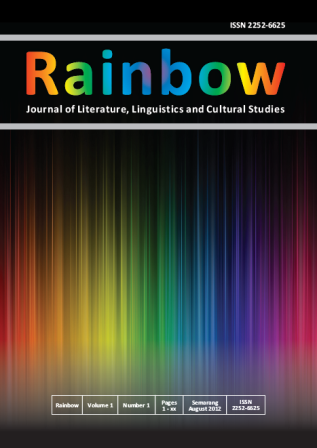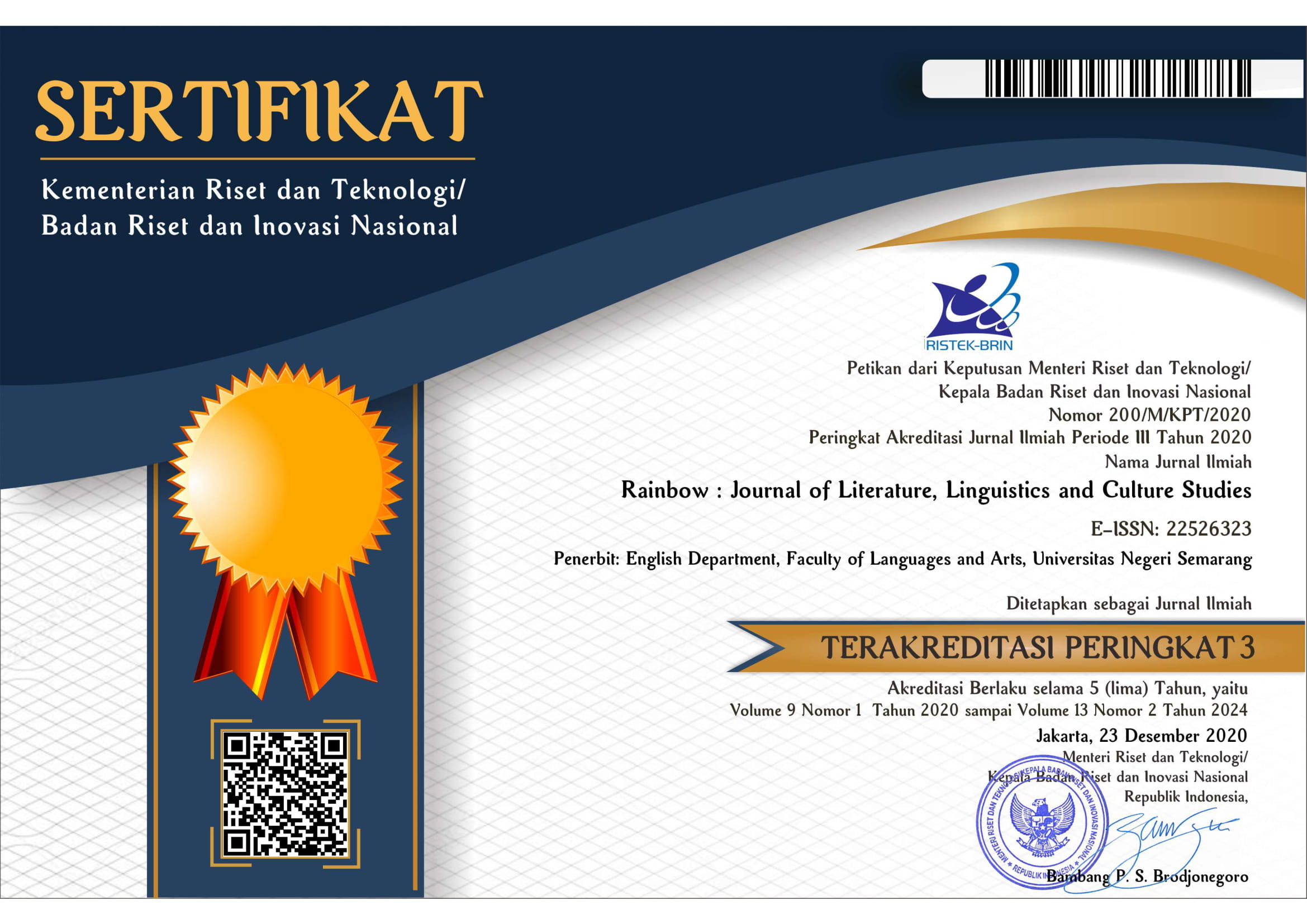HENRIK IBSEN’S A DOLL’S HOUSE: WOMAN’S FIGURE REPRESENTATION IN THE VICTORIAN ERA
Abstract
This study aims to analyze woman’s figure representation which was portrayed in Henrik Ibsen’s play A Doll’s House during the Victorian era. The method used is descriptive qualitative. It focused on the words, phrases, sentences, monologues, and dialogues as the data to analyze. The data were also analyzed by using sociological criticism on feminist critique. By using this criticism, the work is analyzed, especially in how Henrik Ibsen depicted woman’s figure in his play. The analysis results in two findings. Woman’s figure representation in this play is portrayed by Nora’s character and by the symbol of “doll.†Woman’s figure represented by Nora’s character was complex that she prances about in the first act, behaves desperately in the second, and gains a stark sense of reality during the final of Henrik Ibsen's A Doll's House. In the first, act she represents childlike qualities such as childish, deceptive, obedience, conceited, inconsistent, unadorned, insisted, and dependence. In the second act, she represents a desperate woman by being manipulative, insecure, and seducer. In the final act, she represents mature qualities such as becomes calmer, bolder, and more independent. Woman’s figure represented by the use of “doll†as a symbol of woman in this play is that both Nora and the doll are demanding treatment, demanding leadership, and having physical beauty that can give amusement.References
A Doll’s House by Henrik Ibsen. [Online] Available at www2.hn.psu.edu/faculty/ jmanis/h-ibsen/dolls-house.pdf [accessed April 26, 2013]
Abrams, M.H. 1999. A Glossary of Literary Terms. [Online] Available at http://www.ohio.edu/people/hartleyg/ref../abrams_mh.pdf [accessed January 26, 2015]
Benstock, Shari et al. 2002. A Handbook of Literary Feminism. New York, Oxford: Oxford University Press. [Online] Available at http://www.english.uga.edu/~eberle/homepage%20materials/benstock_literaryfeminisms.pdf [accessed January 26, 2015]
Burns, N. and Susan Grove. 2003. Understanding Nursing Research. 3rd ed. Philadelphia: W Saunders Company.
Critical Approaches to Literature. [Online] Available at http://yourbac.weebly.com/uploads/8/0/3/1/8031931/critical_approaches.pdf [accessed September 5, 2014]
DiYanni, Robert. 2007. Literature: Reading Fiction, Poetry and Drama. New York: McGraw Hill.
Holloway, I. and Stephanie Wheeler. 2002. Qualitative Research in Nursing (2nd ed). Oxford: Blackwell.
Kennedy, X.J. and Dana Gioia. 2010. Literature: An Introduction to Fiction, Poetry, and Drama, 11th ed., New York: Pearson Longman.
Lethbridge, Stefanie and Jarmila Mildorf. 2008. Basics of English Studies: An introductory course for students of literary studies in English. [Online] Available at http://www2.anglistik.uni-freiburg.de/intranet/englishbasics/ PDF/Drama.pdf [accessed September 11, 2014]
Lund, Mark. 1996. Literary Criticism: A Primer. Baltimore.[Online]Available at www.bcps.org/offices/.../hs_literarycriticism.docx. [accessed September 11, 2014]
Morner, K, and Ralph Rausch. 1998. NTC’s Dictionary of Literary Terms. Illinois, USA: NTC Publishing Group.
Parahoo, K. 1997. Nursing Research: Principles, Process, Issues. London: Macmillan.
Prasetyo, Budi. 2008. Men’s Arrogances as Reflected in Henrik Ibsen’s “A Doll’s Houseâ€. Final Project.Universitas Negeri Semarang.
Salvucci, G. (n.d). The Victorian Period 1830-1901. [Online] Available at https://groundlings.wikispaces.com/file/view/Victorian+Period.pdf [accessed September 11, 2014]
Scott, Wilbur. 1962. Five Approaches of Literary Criticism. New York: Macmillan Publishing Co., Inc.
Smith, K. 2013. Literary Criticism Primer: A Guide to the Critical Approaches to Literature. [Online] Available at http://herefordhs.bcps.org/UserFiles/Servers/Server_3705599/File/Academics/English/New%20Lit%20Crit%20Primer.pdf [accessed September 5, 2014]
Stormbroek, Anne Van. 2013. Why are We Attracted to Dolls? [Online] Available at http://annevanstormbroek.nl/scriptie.pdf. [accessed September 5, 2014]
Wulandari, Ratri. 2012. Conflict-Based Spectacle Design for Ibsen’s Drama “A Doll’s Houseâ€. Final Project.Universitas Negeri Semarang.







